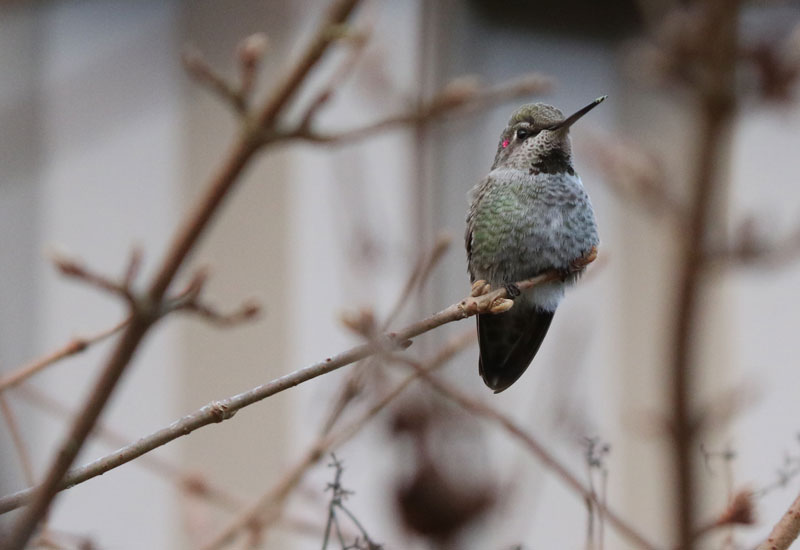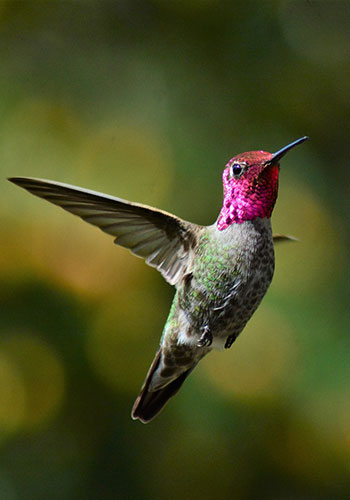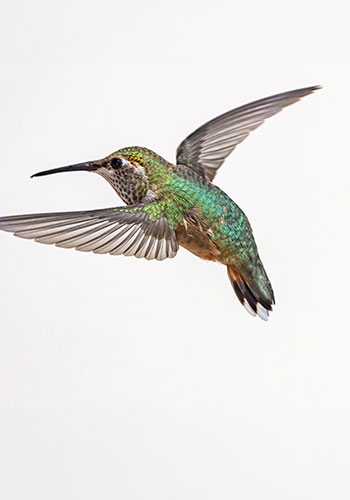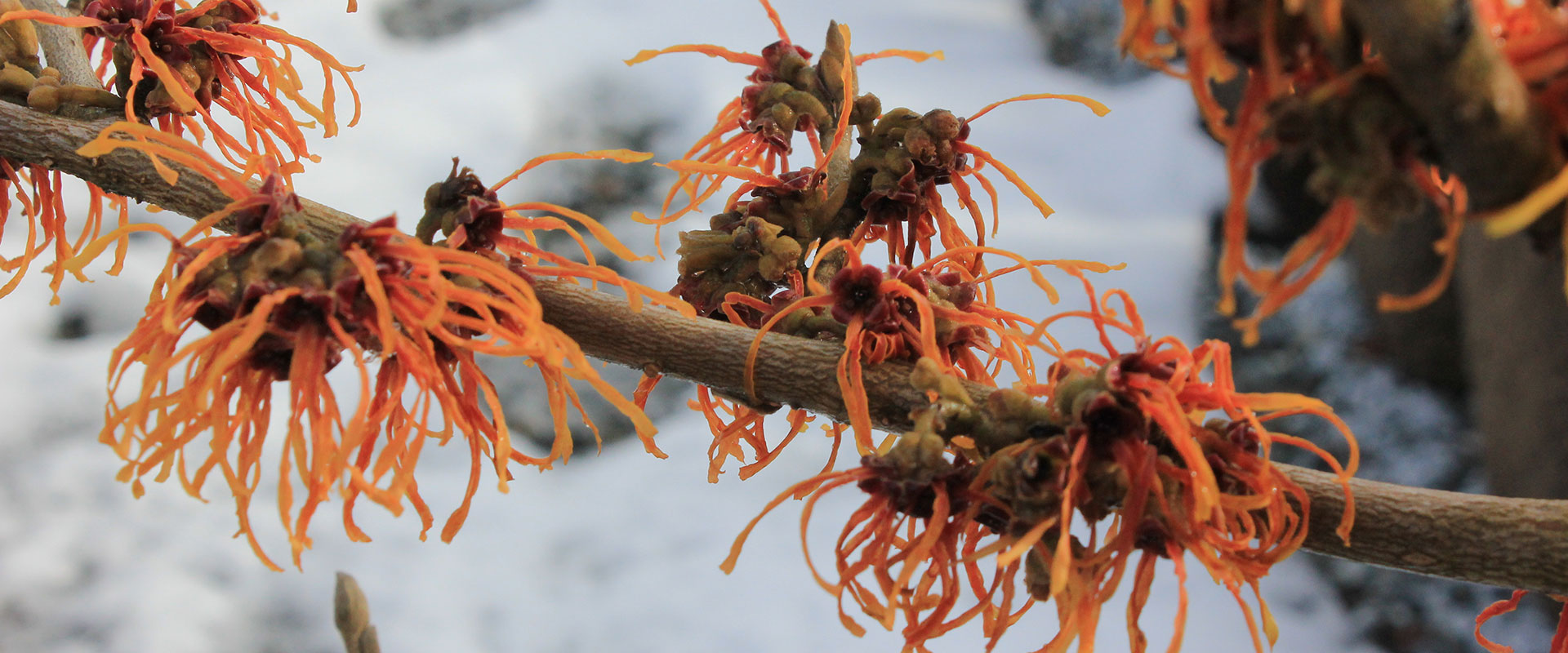Over-Wintering Hummingbirds in the Puget Sound Area
Many gardeners are fascinated by hummingbirds, and for good reason! These tiny garden friends are simultaneously adorable and magnificent, and that’s just one of their many captivating contradictions.

Who would ever expect that these miniature, delicate-looking creatures were not only incredibly quick, but also extremely resilient and hardy? That’s probably why many gardeners are surprised or even concerned to see a tiny hummingbird flitting around right through all the snow, sleet, and hail of our long winter months.
You may even have heard rumors that keeping feeders out too late into the fall will confuse hummingbirds into staying here in the cold when they should head for warmer habitat. But nothing could be further from the truth.
We want to separate hummingbird fact from fiction, and help you learn how to celebrate and appreciate these unique creatures every month of the year.
"You may have heard rumors that keeping feeders out too late into the fall will confuse hummingbirds..."
A Winter Jewel with Wings
While we have a number of different species of hummingbirds that live in the Northwest for some period of time, it is only the Anna's hummingbirds that stick around through the winter.
(For more info on other NW species, check out this great PDF guide from the USDA)


These are the brilliant, green-feathered visitors (males have a touch of pink on their heads) that you’ll see popping by for a quick hello, even when there’s snow on the ground and it seems like they couldn't possibly want to be flying around. And yet, they happily thrive, right through the longest and coldest of NW winters.
Remarkably Resilient
Although the sight of a tiny iridescent bird huddled in puffed-up feathers in the classic Seattle "snain" (snow-rain) might tug on our heart strings, the fact is that these critters are amazingly well-equipped to survive through the winter on their own.
For one thing, they are absolute rock-stars at foraging. The percentage of a hummingbird’s brain that is dedicated to spatial learning and memory is up to five times bigger than that in most other birds. They use this super-power to pinpoint exactly what is blooming when throughout their entire territories. That means they are perfectly capable of finding enough to eat without human help, even in the winter. It also means they will remember where your nectar-rich plants and feeders are and return to them again and again — definitely good news from a bird-enthusiast’s perspective!
Anna’s hummingbirds also use a nifty trick called torpor to get through particularly lean or challenging times. When the going gets rough, these resourceful birds will hunker down in a nice safe thicket and basically take an extra hard-core nap. During torpor, a hummingbird’s body shuts down all but the most essential functions, allowing them to use only half of the energy that they normally would.
Finally, Anna’s hummingbirds eat insects and spiders in addition to nectar, and they are also very good at living off of stored energy. Every time they have a few extra calories to spare, they convert them to fat, which they can then slowly burn while they’re in torpor during the night or through a particularly rough weather day.
"Anna’s hummingbirds seem to be among those scrappy few species, alongside the likes of racoons & crows, that actually thrive on city life.

City-Savvy
Although you wouldn’t think it to look at them, Anna’s hummingbirds seem to be among those scrappy few species, alongside the likes of racoons and crows, that actually thrive on city life. In fact, they didn’t always live this far north, but they have expanded their range in response to human activity.
They were originally restricted to southern California where they could travel up and down mountain slopes to catch blooming gooseberries at any time of year. But they have followed the open habitats and introduced winter-blooming plants of gardens and parks both north and east. Today, they can be found in human-modified habitats along the entire west coast, and have been spotted as far east as Arizona.
The story is different, however, for Rufous hummingbirds. Although they are not yet considered threatened or endangered, their populations are in decline. The main culprit seems to be climate change, and scientists expect things to keep getting harder for them.
"We all know kids love watching bright flashing colors, so why not encourage them to look for them through a window instead of on a screen?"
Hummingbird Feeders: Harmless & Fun
This may burst some bubbles, but we’re going to tell you the truth: hummingbird feeders are more for birdwatchers than birds. Anna’s hummingbirds are so scrappy that they really don’t need any extra help. And unfortunately, addressing the challenges Rufous hummingbirds face will require large-scale and holistic changes that go beyond what individuals acting alone can do.
That said, go ahead and put up a feeder!
As long as you do it right (more on that in a moment), studies show that offering sugar-water feeders will not harm any species of hummingbirds. They’ll simply consider your feeders one more food source to choose from, and a little artificial nectar seems to be a perfectly healthy supplement to their overall diet.
Feeders are a fun and easy way to admire these amazing creatures, and bring some bright and vibrant life to a dreary winter garden. They can also provide opportunities to help kids develop an appreciation for the natural world. We all know kids love watching bright flashing colors, so why not encourage them to look for them through a window instead of on a screen?
And don’t worry, you won’t confuse Rufous hummingbirds and prevent them from migrating by continuing to offer food through the fall and winter: they’re smarter than that. They rely on day length, not food availability, to let them know when it’s the right time to head south.
"Hummingbirds slurp up nectar through amazing tongues that act like piston-pumps."
Tips for Bird Friendly Feeders
Make sure your feeders are healthy for the birds who visit them! Keeping a bird-safe hummingbird feeder isn’t difficult, but there are a few things to keep in mind:
- Clean regularly: Dump out any old sugar-water at least once per week, and clean the feeder with a solution of one part white vinegar to four parts water. Rinse well with plain water before restocking with fresh sugar solution.
- Keep away from cats: Hang your feeders high off the ground, and not near any shrubs or ledges that a cat could reach. Hummingbirds don’t mind their feeders being out in the open, and they will happily come to feeders right outside a window, which is good news for those of us who love to watch them!
- Stick with plain white sugar: If you make your own hummingbird food, don’t try to get fancy. Refined white sugar is the most similar thing to the sugar in natural nectar that you can buy. Honey, corn syrup, brown sugar, raw sugar, and other sweeteners could hurt your hummingbirds. Clear sugar-water in a colorful feeder will work just fine, so there's no reason to add red dyes.
- Use one part sugar to four parts water: Don’t be tempted to increase the sugar content, even to help prevent freezing. Hummingbirds slurp up nectar with amazing fringed tongues (a similar design was actually used to increase the effectiveness of swabs for covid-19 tests) and thicker syrup is hard to slurp. It might also be harmful to their health if they do manage to drink it. The Seattle Audubon Society has some great tips for keeping your artificial nectar thawed and ready to drink.
Winter Hummingbird Plants
Another way to attract hummingbirds to your garden in the winter is to plant winter-blooming flowers. There are quite a few benefits to going this route, even if you also choose to supplement with some artificial feeders.
While sugar water doesn’t seem to be harmful and does provide plenty of calories, nectar fresh from flowers is a hummingbird’s natural diet and likely provides trace nutrients that refined sugar lacks. You won’t have to worry about thawing or cleaning these “feeders” (just protecting them in case of a sudden harsh freeze), and they’ll restock their nectar supplies on their own. Plus, they’re beautiful in their own right!
Contrary to popular belief, hummingbirds aren’t super picky about their flowers. While tube-shaped flowers and bright colors do seem to particularly interest them, they’ll be happy to drink any nectar they can reach. A few especially popular winter-bloomers include winter jasmine (Jasminum nudiflorum), ‘Charity’ mahonia, and witch hazel (Hamamelis species). You can see our full list of recommended hummingbird plants by season in our pollinator list here.

Feeders can be a fun way to attract hummingbirds even if you don’t have room for many plants or to bring them right up to your window. But if you can swing it, the best way to keep hummingbirds flitting around your garden is to have something in bloom for them every month of the year. Have fun, and thanks for growing plants and engaging in practices that support our wildlife neighbors!
Based on Original Content written by Geoff Berg
Original publish date: January 9, 2015
Updates Made: April 16, 2023 and June 27, 2024
